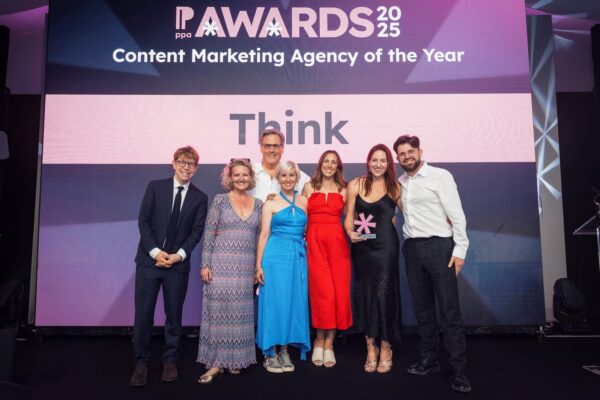Incorporating useful video into your content marketing plan can feel challenging, but Think’s video consultant, Jon Mowat, explains how human psychology can make it simpler.
There’s no denying that quality video content works exceptionally well. A highly visual and captivating medium (when done correctly!), Statista claims that 3.4 billion people consumed online video content in 2022. Pretty impressive.
But according to our latest Re:member research, 47% of consumer membership organisations and 58% of professional claim it’s a subject in which their organisations would benefit from the most training.
So, why does video content work so well? And does it outperform good old-fashioned written content? We spoke to Jon Mowat, Think video consultant and founder of Hurricane Media, to find out why video is taking over the world, how membership organisations can harness the psychology behind this to engage their audiences, and how not to create a ‘spork’.
Touch and feel
While a piece of written content can evoke certain feelings and drive behaviour change from audiences, Jon believes there are five key reasons why video is the single biggest medium that can change behaviour.
You’ve likely heard of the reward chemical ‘dopamine’, which was traditionally released when we did something useful as cavepeople as a motivator to progress us as a species. For instance, we’d get a small kick of dopamine when interacting with others, as this made us feel we were doing something good for society, or we’d get a dose of it when we achieved things like finding food, as this motivated us to get out and do it.
However, Jon explains that nowadays we have something at the end of our fingertips that helps us find things, do things, feel part of a community, and that helps us achieve goals: our smartphones.
As a result, every time we interact with our phones, we get a little kick of dopamine. When you’re scrolling on your phone and you find a bright, colourful video that helps you feel part of a community, you’ll probably get a kick of dopamine.
Therefore, touching and interacting with phones and sociable content makes people feel happy – and if you can provide this interactive, captivating video content, your members will feel positively inclined to engage with it.
Moving images
Likewise, content that moves more gets seen more, and Jon says this is because it’s physically more enjoyable to our eyes.
We each have a group of ‘ganglion cells’ in our eyes, and these have evolved to detect movement in the scene they’re looking at. As we’ve evolved to be aware of moving things around us, the moving images in video content naturally attract our attention better than, say, a wall of text would.
So, when a person scrolls on a phone or laptop and sees something moving, they’re much more likely to stop and engage with it – and get much more pleasure out of doing so.
Emotional storytelling
Humans love telling and listening to stories, and Jon attributes this back to when cavemen told stories around the campfire. While video content is a brilliant way to tell a story, it also has the advantage of being able to tell emotional stories on a much deeper level.
When you hear an emotional story – and you stop listening objectively as you start listening emotionally – your brain chemicals and brain waves start to change. When MRI scans have been done on people telling and listening to stories, both people’s brain waves change to be almost in parallel, literally depicting captured attention.
This is why marketing teams started to tell emotional stories. Once you’ve got people to engage on an emotional level, you probably don’t need to tell them the rest of the story. Emotion can overpower logic and therefore change behaviour.
So, when organisations harness the power of emotion in video, they’re much more likely to drive the desired results.
Plugging in to the system
So, emotional drivers are vital, but how do you tap into someone’s brain to make this work? Jon uses the System 1 and System 2* brain model to illustrate how emotional storytelling grabs attention.
System 1 is the basic part of our brain; the part that receives stimulus and reacts. This part takes care of easy, unconscious reactions – like if a car comes towards you and you step out of the way. It’s essentially your ‘autopilot’; it doesn’t use much glucose to function as it helps you make small decisions unconsciously.
System 2, however, is your conscious thinking – the part that kicks in when you need to make a bigger decision, like which house you’re going to buy, or what you’re going to say when making a speech. As brains are quite lazy, you’ll automatically rely on System 1 to make decisions as much as possible, only transitioning to System 2 brain if really needed.
As System 1 is motivated by emotion, Jon explains that if your video can talk directly to this part of someone’s brain, you can essentially get them to make an emotional decision without really considering it too deeply. Open your video with an emotional connection – something your viewer will care about and want to buy into – and this will encourage unconscious decision-making.
It all sounds a bit sneaky and manipulative, but when you’re using video to change things for the better, it’s a great tactic to encourage positive behavioural change. For example, Hurricane Media often works with the charity Shelter, and Jon uses this technique to target and engage their multiple demographics. Shelter uses emotional, personal storytelling to ensure its videos resonate emotionally with the target audience. The emotional message here is ‘homelessness could happen to anybody; it could happen to you’, therefore driving action from the audience.
*Ps, while these aren’t actual parts of the brain, they are psychological frameworks illustrating how people make decisions.
Advanced segmenting and targeting
Whereas previously video had to be broadcasted to the masses via TV, nowadays we can use advanced targeting and segmenting to ‘monocast’ to specific people to capture their attention. This targeting means we have the most effective 1-to-1 communication we’ve ever had.
You can target via demographic; by people’s likes and interests; what they talk about online, where they go… to name a few things. More personalised video equals more views and more action, as you’re speaking more personally to your desired group.
But in order to do this, you must know your audience well – decide who they are, why this video would matter to them and how it’s going to impact them, then target your product accordingly.
Final thoughts: how to make video content that works
With the psychology behind video covered, Jon recommends considering these two important questions when planning your video content:
1. Will your video inform and entertain your audience?
2. Will it meet a business goal or objective?
When coming up with content ideas, think about whether your video will engage who it’s supposed to, whether they will care what it’s saying, and if it will make them feel something. You’ll find formal pieces to camera in uninspiring locations won’t quite cut it.
Then, consider which business goal or objective your video will hit. For instance, can your video include a CTA that encourages the viewer to sign up for a membership? How can signing up for your membership enhance your audience’s life? What could happen if they don’t? If you set a specific target, then use your data to illustrate that’s what the video has pushed people to do, you can demonstrate that you’ve made a good piece of video content.
But Jon’s final tip is to make sure you don’t get dragged into the temptation of making a ‘spork’. He uses the ‘spork’ (spoon and fork) analogy to describe a piece of content that tries to be too many things to too many different people. Like a spork, a piece of content like this doesn’t really do anything well – it’s a bad fork, and a bad spoon.
To avoid this, determine specific business goals, specific audiences, and specific things that you want your video to achieve ahead of time. And don’t overdo it – utilising a multimedia approach, with content hubs that provide a range of content (video, written, audio etc) will ensure your members have plenty to engage with over a longer period of time.





